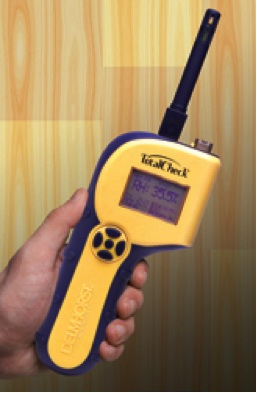 For woodworking projects, tracking the moisture content of the wood you’re using is a major concern. Whether you’re acclimating lumber for distribution elsewhere, or you’re installing wooden flooring in a newly-constructed building, you need the best wood moisture meters to ensure top-quality work.
For woodworking projects, tracking the moisture content of the wood you’re using is a major concern. Whether you’re acclimating lumber for distribution elsewhere, or you’re installing wooden flooring in a newly-constructed building, you need the best wood moisture meters to ensure top-quality work.
How do you choose the best moisture meter for flooring and other woodworking jobs, however? There are two major types of moisture meters commonly used for woodwork, pin-type meters and pinless meters.
Both of these types of moisture meters have their respective strengths and weaknesses, and opinions about which type is the best varies from one person to the next. Pin meters have the advantage of being more precise when it comes to allowing woodworkers to know the depth at which moisture pockets lie in a piece of wood, but pinless meters tend to allow for faster scanning of large, flat samples of wood.
Why should these two types of moisture meters be mutually exclusive? Why can’t we simply have the functions of both in one device?
Actually, it is possible to get the benefits of both types of moisture meters in a single device. In fact, there are several benefits of using an all-in-one moisture meter.
Benefit #1: Increased Speed and Accuracy in Pinpointing Moisture Pockets
When you have an all-in-one meter, you can use the pinless scanning mode to quickly take numerous readings of the moisture content of a large area of wood flooring or numerous large, flat, lumber samples to find the general area where a moisture pocket is located, and then pinpoint the location and depth of said moisture pocket using the pins on the meter.
This allows you to track down the exact location of any moisture pockets fast so that you can deal with them.
Benefit #2: Saving Space on Your Tool Belt
By combining the functionality of both pin and pinless meters, an all-in-one meter can save you some space on the old tool belt. Instead of carrying around a pin-type meter, a pinless meter, and a thermo-hygrometer, you can simply carry one device that has the functions of all three.
Also, instead of having to care for and store three separate devices, you only need to maintain the one, which should make after-job maintenance for your tools a little bit easier as well.
Benefit #3: Increased Utility
There are a few jobs at which pinless meters excel at over pin-type meters, and there are tasks for which a pin-type meter is much more useful than a pinless meter.
For example, when monitoring moisture in large, flat pieces of wood, such as wooden planks for flooring, a pinless meter is ideal for quickly scanning these flat objects. However, the great weakness of the pinless meter is that is requires a flat surface in order to work. In woodwork with artful grooves and decorations, a pinless meter is useless.
With an all-in-one meter, on the other hand, all you would have to do is switch modes and you could take a reading in an irregularly-shaped piece of wood.
For finished wood products that you would not want to mar with pin holes, you could switch your meter from the pin-type mode to the pinless scanning mode and get your measurements without leaving a mark.
By using an all-in-one meter, you’re ready for a larger variety of tasks than you would be with either a pin-type or pinless moisture meter.
Getting the Best of Both Worlds
Instead of limiting yourself to one type of meter or the other, you can get the best of both worlds by using an all-in-one device that can be freely switched between a pinless scanning mode and pin mode. Learn more about all-in-one devices such as the TotalCheck 3-in-1 from Delmhorst!

Comments